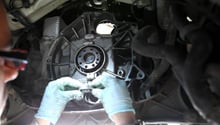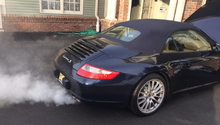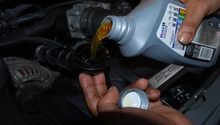Porsche 997: Why Are My Tail Pipes Sooty?
Black, sooty tailpipes aren't the best sight to see. The question is whether or not this is normal in a Porsche 997. Find the answer here.
This article applies to the Porsche 997 (2005-2012).
There are many things that come along with enjoying your Porsche 997. Wear and tear is a double-edged sword. On the one hand, it shows that we use our 911s as they are meant to used, and on the other hand it leaves the car with some unsightly signs of wear. One of these wear signs are black, sooty tailpipes. Some may say it's normal, while others may say that your car has an issue that needs to be addressed. So, which one is it? This article explores some reasons for black soot on your 997's tailpipes and outlines a series of questions you should consider to narrow down the issue.

Let's begin by remembering that the 997 engine is a controlled explosion generator. It takes a fuel source, air source and an ignition source, combusts them, and then harnesses the power generated from them. As clean burning as new engines can be, there is still a byproduct of this combustion which can actually turn up in the form of black soot. The next question is, how much black soot is from normal combustion and at what point is there too much? This will obviously depend on many factors and will essentially be up to your better judgement. If it seems to be excessive, then there are numerous different checks that can be done to make sure all the systems and their components are working correctly.
Is the Check Engine Light On?
One of the easiest ways to check to make sure everything is running correctly is to see if your check engine light is on. Your 997 is equipped with many different monitors and sensors that keep tabs on how things are running. If any of these sensors or monitors fail or start to run incorrectly, then this could cause your car to run rich or improperly, which could then lead to black soot.
Remember that the check engine light is an actual component in the system, and just because it's not on, doesn't mean everything is okay. The check engine light can fail also, so it's best to have the system checked with a scanner just to be on the safe side.

Has the 997 Had Proper Break-In?
New engines or rebuilt engines require a break-in procedure and interval. This is due to the fact that the pistons in your engine have rings on them that each perform a different task such as sealing against the cylinder wall and scraping the cylinder of oil as it travels up and down. These rings, because they are in close tolerance with the cylinder wall, need to, in a way, have time to seat with the cylinder wall. That's about as simple as it can be explained. Porsche requires a certain procedure to ensure that this occurs properly. If break-in isn't performed successfully, then it is possible that the rings have not seated correctly and can cause compression issues with your engine as well as oil blow-by.
If you purchased your 997 brand new, then you were responsible for the break-in. If you purchased your 997 second-hand, then the previous owners were responsible and it might be tricky to figure out whether they did it correctly or not.

Is Oil Consumption Occurring?
An engine consuming oil can be caused by a few different reasons. Technically, engines are not supposed to consume their own oil unless it is a two-stroke engine, but it does happen from time to time. Porsche has limits on the quantity of oil an engine is allowed to consume before it becomes a problem. It is possible that if an engine is consuming oil it will leave black soot as a byproduct of this consumption.
One cause of oil consumption could possibly be a problem with one of the cylinders, such as scoring or a piston ring issue. A common way to check to see if this is the case is to have a compression test and/or leak down test performed on the engine. It is also a good idea to see if a scope of the cylinders can be done. This will provide a visual inspection to see if there is a problem with the engine.
Another good way to check to see if your engine is consuming oil is to perform an oil change and then monitor the oil level over the course of about 1,000 miles or a long drive. Check the oil level throughout these miles and make a record if the oil level changes, by how much, and at what mileage.
Is the Oil System Overfilled?
The oil level on a car is extremely important for proper engine operation. Most people know that not having enough oil in the oil system is definitely a problem, but few understand that overfilling an oil system can also cause issues. That extra oil will have to go somewhere simply because there is no room for it. All oil systems have some sort of breather system so that they do not build up excessive pressure. Due to emissions regulations, the car's breather system is designed to breath back into the intake tract of the engine. If an oil system is overfilled, that excess oil is most likely going to make it back into the intake tract and then be burned up in the combustion chamber, most likely creating some nice black soot. If you do figure out that your oil system has been overfilled, then it is best to drain off the extra oil instead of letting it get burned up.
Is the Air-Oil Separator Working Correctly?
997s are equipped with air-oil separators. This device is an emissions component that collects vapor and residual gases and directs them back into the intake tract. If this device fails, it will cause oil to pass through the separator and make its way into the intake tract as well. There are tests that can be performed to see if your air-oil separator is working correctly.

Related Discussions
- Oil Consumption and Sooty Exhaust Tips - Rennlist.com
- Left Exhaust Tip Gets Black - Rennlist.com
- 997 Engine Replacement - Rennlist.com






